Projects
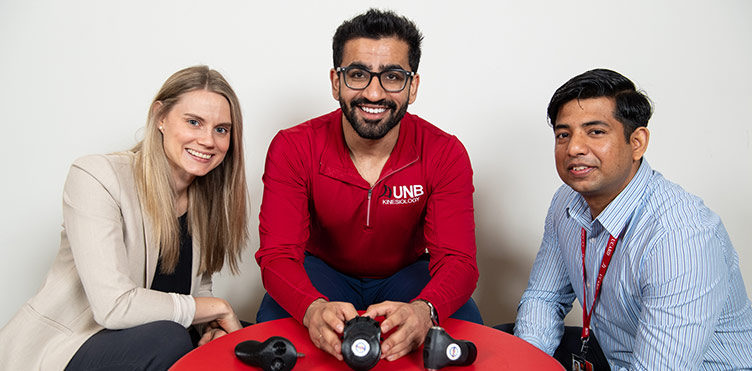
Research initiatives
Healthcare ergonomics
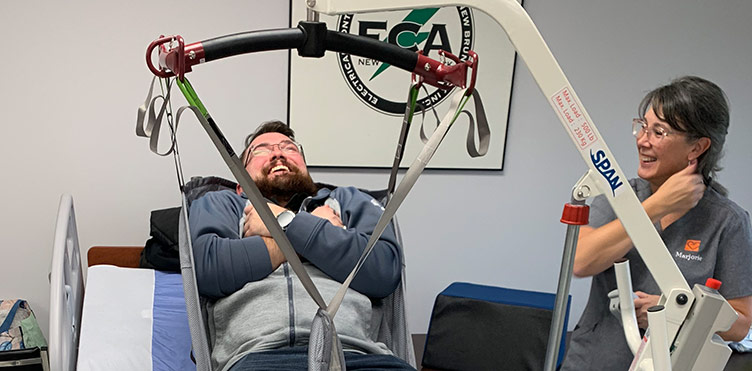
The current major research focus in the lab is on patient handling. Healthcare providers report some of the largest musculoskeletal injury (MSI) rates and lost days on a yearly basis with most of the injuries being related to patient handling (repositioning, transferring from bed, toileting and bathing activities).
A series of projects are currently being conducted to understand:
- The epidemiology of the healthcare challenge;
- quantifying the physical and biomechanical demand of specific patient handling techniques;
- the evaluation of technology and patient handling aids to reduces MSI;
- understanding the barriers and facilitators to implementing safe patient handling programs in acute and long-term care facilities; and
- determining the effect of training on patient handling adherence.
Active sitting
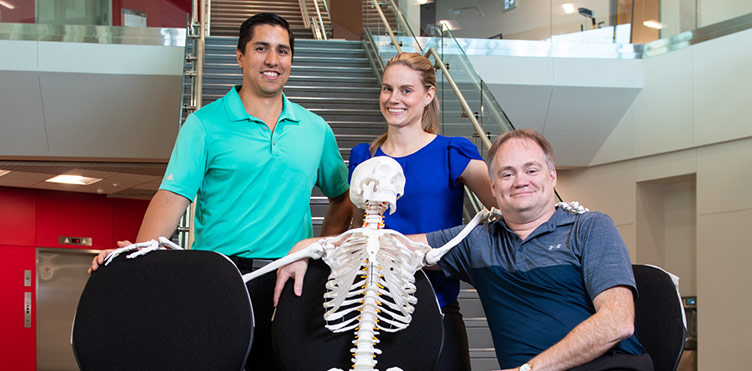
The average office worker spends 70% of their time sitting. This has led to a number office designs to help reduce the demands related to prolonged sitting, including active sitting.
An active chair allows the sitter to provide the action to move the chair, while the mechanism of the chair accommodates that action.
A series of research projects were undertaken to explore the physiological and biomechanical benefits of incorporating active seating at a computer workstation.
Active seating requires the user to ‘actively’ engage movement of a chair. An active seat with a split pan design allowed the user to actively peddle their feet while sitting allowing for increased blood flow to the legs.
Published findings
Effects of implementing an active sitting protocol compared to using a traditional office chair and standing workstation. International Journal of Industrial Ergonomics, (2024).
The biomechanical benefits of active sitting. Ergonomics 66(8):1072-1089.
Active workstations: A literature review of workplace sitting. Journal of Bodywork & Movement Therapies, 38(2024): 406-416 4.
A biomechanical analysis of active vs static office chair designs. Applied Ergonomics, 96: 103481
Lifting and low back loading
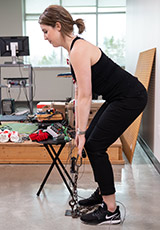
Dr. Albert’s NSERC funded research has been focused on lifting, more specifically on the modifications to lifting technique related to prolonged lifting. To identify modifications a waveform analysis approach (Principal Component Analysis -PCA) has been used.
Work to date has focused on general fatigue modifications as well as modifications related to specific fatigue to the arms, back and legs, respectively.
Applied research associated with lifting and back loading has been involved with determining cumulative exposure on back loading during manufacturing activates and modifications to biomechanical demands when manual material handling activities are performed in moving environments (i.e., off-shore industry)
Published findings on lifting modifications
Differential effects of sex on upper body kinematics and kinetics during fatiguing, asymmetrical lifting. Applied Ergonomics, 116.
The effect of gender and time on spine and shoulder biomechanics during a prolonged symmetrical lifting task. IIE Transactions in Occupational Ergonomics and Human Factors, 3(3/4):165-176.
Are Males and Females Similarly Consistent in their respective Lifting Patterns? Theoretical Issues in Ergonomic Science, 9(4):347-358.
Principal Component Analysis of Lifting Waveforms. Clinical Biomechanics, 21(6): 567-578.
Discriminating lifting technique for future low back pain development. Clinical Biomechanics, 20(3), 254-263.
Monitoring Individual Erector Spinae Fatigue Responses Using Electromyography and Near Infrared Spectroscopy. Canadian Journal of Exercise Physiology, 29(4):363-378.
Published findings on cumulative joint loading
A validation of a posture matching approach or the determination of 3D cumulative back loads. Applied Ergonomics, 39:199-208.
Methodological Considerations in the Calculation of Cumulative Exposure: An Assessment of Joint Model and Time Standardization Approaches on Error. Ergonomics, 50(9):1365-1377.
Published findings on working in moving environments
The habituation of human postural responses to platform perturbations. Industrial Journal of Industrial Ergonomics, 44:874-881.
Stepping response during constrained and unconstrained standing environments. International Journal of Maritime Engineering, (Transaction RINA Part A) Vol 156, Part A3 July-September.
A comparison of platform motion waveforms during constrained and unconstrained standing in moving environments. IEEE Transactions in Occupational Ergonomics and Human Factors, 1:140-151.
The effects of moving environments on thoracolumbar kinematics and foot center of pressure when performing lifting and lowering tasks. Journal of Applied Biomechanics, 28(2):111-119.
The effect of platform motions upon the biomechanical demands of lifting tasks. Occupational Ergonomics, 10: 103-112.
Effect of simulated vessel motions on thoracolumbar and centre of pressure kinematics. Occupational Ergonomics, 7:1-10.
Effects of moving environments upon the physical demands of heavy materials handling operators. International Journal of Industrial Ergonomics, 37: 43-50.
Transportation / vehicle ergonomics
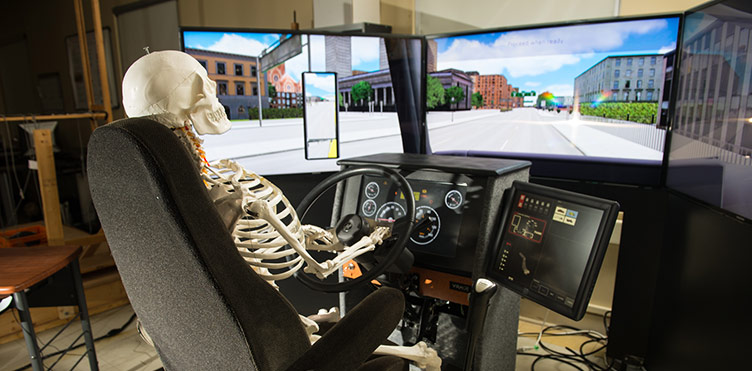
Occupations that involve vehicles as part of the workplace result in various ergonomic challenges. The Occupational Performance Lab has been involved in several projects focused on addressing ergonomic challenges.
The Lab has a VIRAGE full driving simulator that can simulate driving in car, trunk and ambulance as well as a separate chassis to simulate transport truck driving. We can assess urban and rural driving in various weather conditions. To date, the following projects have been undertaken:
Assessment of an ergonomic seat design for long-haul trucking
Occupational Health Profile of Canadian Maritime Truck Drivers. A Journal of Prevention, Assessment & Rehabilitation, 67(1): 251-257.
A pre/post evaluation of fatigue, stress and vigilance amongst commercially licensed truck drivers performing a prolonged driving task. International Journal of occupational safety and Ergonomics, 25(3):344-354.
Evaluation of new truck seat design: A field study. 25(3):331-343. International Journal of Safety Engineering (JOSE).
Biomechanical investigation of prolonged sitting in an ergonomically designed truck seat. Ergonomics, 61(3):367-380. Aug 16, 2017.
Effect of night-vision goggles on neck strain and biomechanics in Canadian helicopter pilots
Posture and helmet load influences on neck muscle activation. Aerospace Medicine and Human Performance, 87(1):1-9.
A Predictive Logistic Regression Equation for Neck Pain in Helicopter Aircrew. Aviation, Space and Environmental Medicine, 83:604-608.
Neck loads and postures experienced by Canadian forces helicopter pilots during simulated day and night flights. International Journal of Industrial Engineering, 41(2):128-135.
Neck pain and muscle function in a population of ch-146 helicopter aircrew. Aviation, Space and Environmental Medicine, 82(12):1125-1132.
Physical demands on bus drivers
Biomechanical and ergonomic assessment of urban transit operators. 39(1):33-44.
Effects of police car design on low back pain
An ergonomic evaluation of city police officers: The analysis between discomfort and patrol duties. International Journal of Safety and Ergonomics, 23(2):175-184.
Quantifying the postural demands of patrol officers: a field study. International Journal of Occupational Safety and Ergonomics, 23(2):185-197.
Physical demands of garbage disposal workers
Manuscript in review
Stress associated with ambulance driving
Physiological responses during paramedic’s simulated driving tasks. A Journal of Prevention, Assessment & Rehabilitation, 66(2): 445-460.
Secondary devices
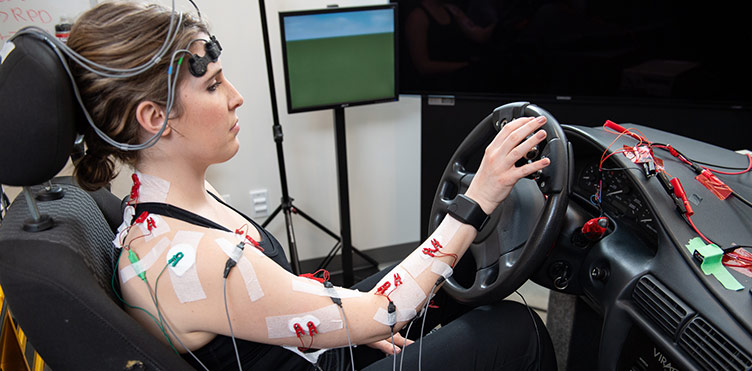
Working with a NB company, the lab was involved in assessing the ergonomic design of secondary devices for use in driving.
Several designs that provided different options for control of secondary devices (i.e., horn, wiper, turn signals) were tested for both their ergonomic fit and their functionality (i.e., reaction time, error rates).
The secondary devices were installed with our driving simulator to assess driving errors when using the devices.
